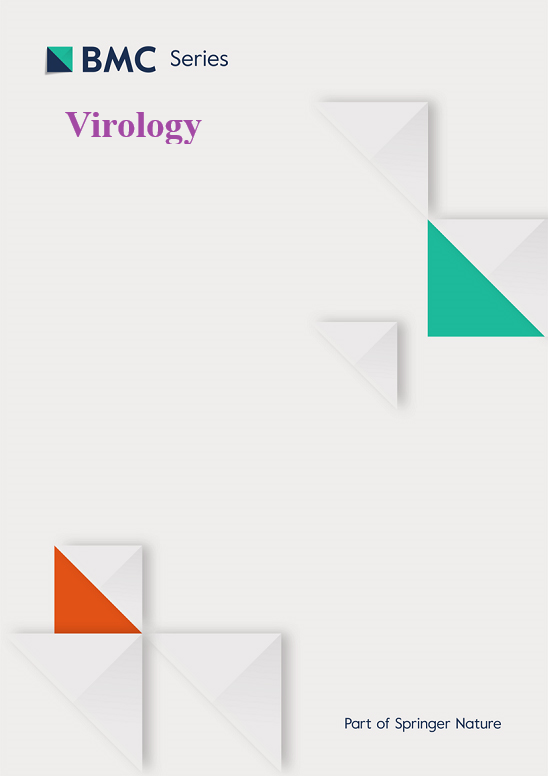MyosinVb tail inhibits transport of Marburg virus glycoprotein GP to VP40-enriched sites at the plasma membrane
IF 2.8
3区 医学
Q3 VIROLOGY
引用次数: 0
Abstract
Marburg virus (MARV) is the causative agent of severe fever with case fatality rates between 25 and 90 %. The glycoprotein GP is the only surface protein of MARV responsible for receptor recognition and fusion. Therefore, proper intracellular transport of GP to the plasma membrane and incorporation into virus particles is essential for the viral infection cycle. However, neither the exact post-Golgi trafficking route nor the host factors are known that support the transport of GP to the cell surface.
Using quantitative confocal microscopy and correlative light and electron microscopy (CLEM), we show here that GP colocalized in both transiently transfected and MARV-infected cells with a dominant negative (DN) tail mutant of myosin Vb (MyoVbT), which inhibits trafficking through recycling endosomes. Overexpression of MyoVbT resulted in an aberrant distribution of GP that accumulated in or near perinuclear MyoVbT-containing structures. Simultaneously, we observed significantly reduced GP levels at the plasma membrane and especially at the viral budding sites characterized by clusters of the viral matrix protein VP40. Further, incorporation of GP into VP40-induced filamentous virus-like particles was impaired by MyoVbT. Overall, our results show that intracellular transport of MARV GP is disrupted by a DN mutant of the recycling endosome-associated motor protein MyoVb. These results might indicate a possible role for the endosomal recycling system in MARV GP trafficking to VP40-enriched budding-sites at the plasma membrane.
MyosinVb尾抑制马尔堡病毒糖蛋白GP向质膜上vp40富集位点的转运
马尔堡病毒(MARV)是引起严重发热的病原体,病死率在25%至90%之间。糖蛋白GP是MARV唯一负责受体识别和融合的表面蛋白。因此,GP在细胞内转运到质膜并并入病毒颗粒对病毒感染周期至关重要。然而,支持GP转运到细胞表面的确切后高尔基转运路线和宿主因子都不为人所知。通过定量共聚焦显微镜和相关光电子显微镜(CLEM),我们发现GP在瞬时转染和marv感染的细胞中都存在肌球蛋白Vb (MyoVbT)显性阴性(DN)尾部突变体,该突变体通过循环核内体抑制运输。MyoVbT的过表达导致GP分布异常,积聚在含有MyoVbT的核周结构内或附近。同时,我们观察到质膜上的GP水平显著降低,特别是在病毒基质蛋白VP40集群特征的病毒出芽部位。此外,MyoVbT还破坏了GP与vp40诱导的丝状病毒样颗粒的结合。总的来说,我们的研究结果表明,MARV GP的细胞内运输被循环内体相关运动蛋白MyoVb的DN突变体破坏。这些结果可能表明内体再循环系统可能在MARV GP运输到质膜上富含vp40的出苗位点中起作用。
本文章由计算机程序翻译,如有差异,请以英文原文为准。
求助全文
约1分钟内获得全文
求助全文
来源期刊

Virology
医学-病毒学
CiteScore
6.00
自引率
0.00%
发文量
157
审稿时长
50 days
期刊介绍:
Launched in 1955, Virology is a broad and inclusive journal that welcomes submissions on all aspects of virology including plant, animal, microbial and human viruses. The journal publishes basic research as well as pre-clinical and clinical studies of vaccines, anti-viral drugs and their development, anti-viral therapies, and computational studies of virus infections. Any submission that is of broad interest to the community of virologists/vaccinologists and reporting scientifically accurate and valuable research will be considered for publication, including negative findings and multidisciplinary work.Virology is open to reviews, research manuscripts, short communication, registered reports as well as follow-up manuscripts.
 求助内容:
求助内容: 应助结果提醒方式:
应助结果提醒方式:


